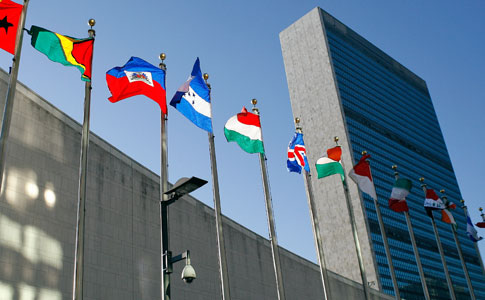NOTE: Alyssa G. Pack is a graduate student in Diplomacy and International Relations at Seton Hall University. Alyssa acquired her bachelor’s degree from Seton Hall University’s School of Diplomacy and International Relations. At the graduate level, she is specializing in Foreign Policy Analysis and Global Negotiation/Conflict Management. After spending a year interning at the Permanent Mission of Malta to the United Nations, Alyssa has keen interests in current United Nations affairs and of reform efforts at the United Nations. Alyssa interned for a non-profit known as Pencils of Promise and wrote as a staff writer of International News for The Diplomatic Envoy newspaper at Seton Hall.
The veto powers held by the Permanent Five (P-5) members of the Security Council at the United Nations has constantly been a controversial issue. Enshrined in the U.N. charter and existing as a disabler of any possible U.N. reform since its creation almost seventy years ago, the veto powers of the P-5 persists as a symbol of U.N. inefficiency. Particularly when needing to act upon international crises, the veto powers of the P-5 prevent the Security Council from doing so, limiting the U.N.’s effectiveness.
The controversial issue of the P-5’s veto powers extends further due to their relevance in determining who will succeed Secretary-General Ban Ki-Moon as the next Secretary-General. The Security Council is the body responsible for recommending a single candidate for the General Assembly to appoint. This is conducted after Member States submit letters to the Security Council nominating their governments’ chosen candidate, which is most likely to be completed later this year.
Because the Security Council chooses a single candidate that will face appointment by the General Assembly, potential candidates who are recommended for appointment by their governments to the Security Council are threatened by the P-5’s veto power capabilities. The use of such capabilities to block whoever these five members seem fit is not uncommon. The United States did this in 2006 to block India’s official candidate in favor of Ban Ki-Moon. This produces a major problem in the election process considering that the secretary-general is to represent the entire UN body rather than solely that of the Security Council or the P-5.
The ideal balance of qualifications for the Secretary-General is still subject to debate. While the office has little power, it is still one a position of great responsibility and expectation, thus requiring a more open and democratic election process. As potential candidates and their governments attempt to tip toe around obstacles presented by the veto powers of the P-5, this may be the year when the inadequate election process sparks action for changing future election processes for Secretary-General.
In order to promote an open process, reforms need to be implemented within several areas. At a minimum, this includes steps such as a formal procedure for acquiring potential candidates (such as through creating a search and nominating committee), requiring a clear timetable for the selection process, and submitting an official list of candidates and their statements that would include their proposed agenda and priorities. Even bolder steps that can be taken, including giving a greater role in the selection process to the General Assembly, electing the Secretary-General through popular vote, or at least proposing more than one candidate to the General Assembly for appointment.
As for the upcoming election process, rumors have already begun to spread on possible candidates, with low key campaigning being undertaken in private meetings at diplomatic missions or at Manhattan coffee shops. Additionally, official endorsements at the national level are already being adopted. Potential candidates range from a wide array of high ranking officials, including presidents, former prime ministers, and foreign ministers from regions all across the globe. Yet many have emerged from Eastern Europe since traditionally, the Secretary-General position has been shared by a rotation of the UN’s five regional groups and Eastern Europe remains the only region that has never produced a Secretary-General. Thus far, the top three potential candidates Eastern Europe is likely to submit to the Security Council includes former Slovene president Danilo Türk, Slovak diplomat Jan Kubiš, and current UNESCO Director General Irina Bokova from Bulgaria.
Avoiding a veto by Russia and the rest of the P-5 will be the goal for such potential candidates, since they need to be perceived as neither too “pro-Russian” nor too “pro-West” in order to achieve approval. But since regional rotation is solely an informal tradition rather than binding, it is possible that if Eastern Europe fails to put forward an acceptable candidate for the P-5 members, a potential candidates not from Eastern Europe, Helen Clark (current UNDP Administrator and former New Zealand Prime Minister) holds a fair chance at gaining appointment. Already running a seemingly strong campaign, the notion of appointing the first woman Secretary-General in history is particularly appealing, along with her neutrality shared among the P-5 members.
The only means in which the future Secretary-General can strengthen the UN to make the United Nations more transparent, effective and efficient is by adopting such reforms despite the threat of the P-5’s veto power. Despite the overarching threat of the veto power’s ability to block any U.N. reforms, if UNSC reform could become part of the UN agenda, so could reform of the SG selection. Hopefully, many lessons can be learned and observed once this election process is completed by October of 2016 and a successor to Ban Ki-Moon is appointed.
